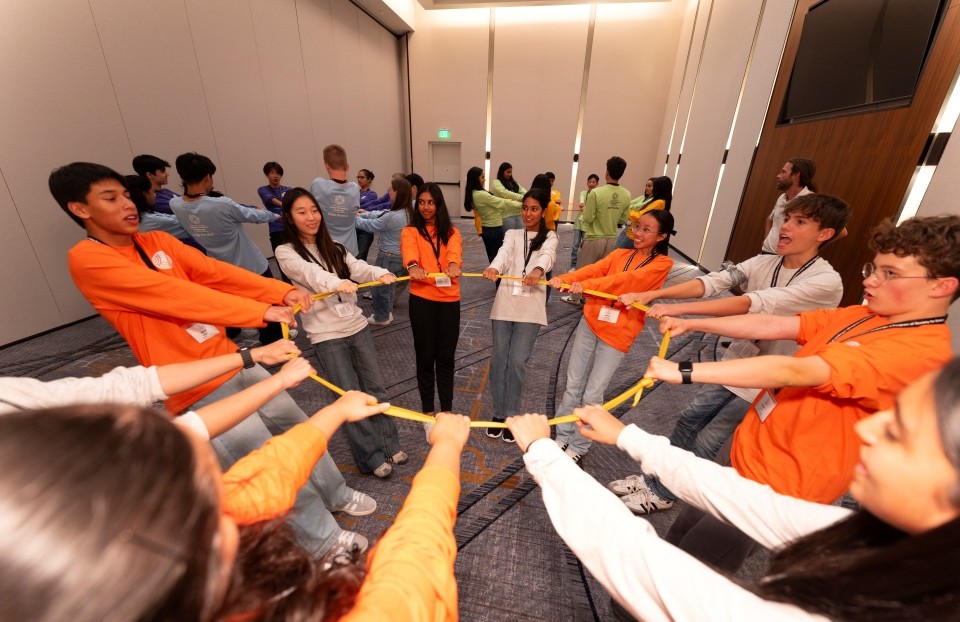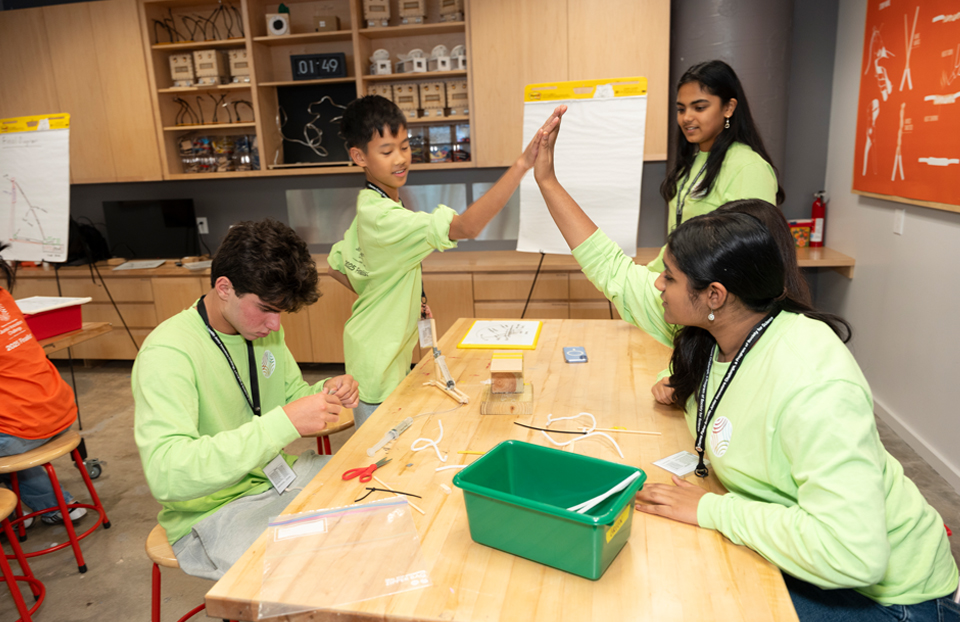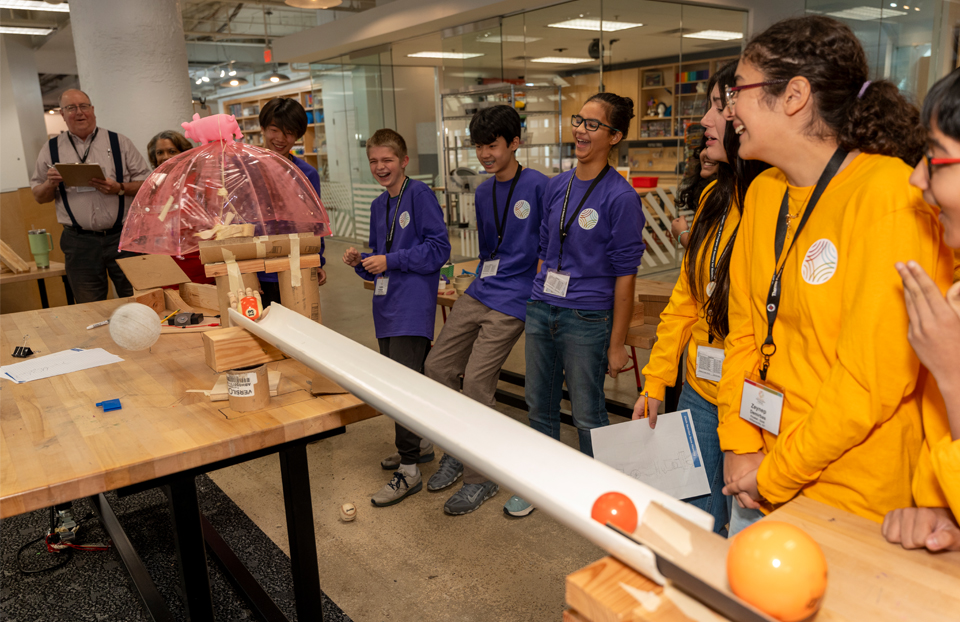Five Questions with Samvith Mahadevan, the winner of the $10K Lemelson Award for Invention in the 2024 Thermo Fisher JIC
Fourteen-year-old Samvith Mahadevan, currently an eighth grader at Canyon Vista Middle School in Austin, Texas, has lived much of his life navigating the challenges of severe food allergies. His journey into scientific research began not in a lab, but at parties and gatherings—places where a simple bite of food could set off an alarming allergic reaction.
“Sometimes, I’d see something that looked delicious and take a bite, only to end up with swollen eyes and itchy skin,” Samvith recalls. The uncertainty of what was in unpackaged or homemade dishes made social settings especially difficult for him. He often found himself wondering, “Why does it have to be me?”
But over time, that question evolved into something more powerful. Rather than seeing his condition as a limitation, Samvith began to view it as a source of empathy and motivation. He realized he could channel his experiences into helping others facing the same risks he had.
For his award-winning project at the Thermo Fisher JIC, Samvith designed a device that functions as an early-warning system for hidden allergens in food. Using a chemical “nose” trained through machine learning, his invention can detect common allergens such as nuts, eggs and processed ingredients. For this innovative work, Samvith was honored with the $10,000 Lemelson Foundation Award for Invention, presented by The Lemelson Foundation to a young inventor whose product-based solution addresses a pressing problem faced by so many people all over the world.
Let’s hear more from Samvith below!
What was a challenging moment you faced while working on your project, and how did you get through it?
Attempting to develop a novel method such as smell based sensors for allergen detection comes with its own unique challenges, and the main one came during the early stages of training algorithms. I had collected training data for peanuts, trained the ML algorithm, and was then attempting to test the simulated accuracy. I had intended this trial as proof of concept of the method, but I saw that the simulated accuracy was significantly lower than I expected at just above 50% to 60%. This was essentially a coin flip or random guess, which was very discouraging, especially so early in the process. At this crossroads, I felt lost, but I just began trying many different things with the training data and algorithm structure. I trained using hot or cold variations of the allergen for training data and also tried different amounts and concentrations of the allergen, but still to no avail. Eventually I settled on a specific configuration of algorithm parameters, which gave much better results at about 90%. While it was a gradual process and required me to continually persevere in the trial and error stages, it was greatly encouraging to get this first success.
Was there a specific “aha moment” when you realized you were on the verge of solving your research problem?
Oftentimes, machine learning algorithms can get tricked when testing real world use cases due to the variations that are present in the sample and not represented in simulated testing. When my algorithms succeeded in this type of testing, on common store-bought products containing allergens, it served as an important “aha moment” in my project’s development. Initially in the process of this project, I was working mainly on developing algorithms that were focused on plain allergen detection. For example, at first, I wrote algorithms for the detection of raw almonds, peanuts, pistachio and walnuts. While these successes were reassuring, I was still not sure how this device would perform on other items. So, I tried the system on some common products such as Twinkies for eggs, almond cereals, walnut muffins. To begin with, I didn’t have high expectations, but I was pleasantly surprised when the testing accuracy stayed consistently high for real world products as with simulated testing with >90% accuracy.
A similar moment came later in the process as well, when I went to test whether the sensor would be able to detect allergens in aromatic foods. With this device being based on olfactory sensing, I was convinced the algorithms would fall victim to the gas compositions of the other spices. But, I was curious as to what would happen anyway, so I tried it on some Indian curries with spices and cashews ground in. I predicted the accuracy for this test would be as low as random chance, but when I achieved 85%+ accuracy, it was another significant “aha moment” that was extremely encouraging and motivating for me. With the accuracy being proven in live testing on real world products, it brought forth the motivation for me to turn this device into a product.
What’s one of the most memorable or surprising experiences from your Thermo Fisher JIC journey?
When I received the call announcing that I was one of the top 30 Junior Innovators, that moment represented the culmination of more than a year’s worth of hard work and dedication. A feeling of pure ecstasy consumed me and gave me so much excitement for the competition week to come. Plus, the call came in one of the most unexpected moments. It had come earlier that day, when I was still in school. I got home and went to my table tennis practice as usual. Nothing seemed out of the ordinary to me. But, on the way, I suddenly got a call from a random number. My mom urged me to pick up which made me slightly concerned. Still, I did as she said and heard those special words telling me that I was a finalist in the Thermo Fisher JIC. I could barely contain my happiness and was literally shaking as I spoke with a Society for Science staff member. I knew that this would be a once in a lifetime opportunity, and it turned out to be one of the best experiences I have ever had. It was truly a magical moment, and I can still vividly recall every second of it.
Can you share a special moment from the competition week? What was your most favorite memorable experience from the competition?
During finals week, we were almost constantly occupied with team challenges, judging and other activities. But, in the bits of free time we had, we got to know our fellow Junior Innovators. It was during this time that we formed a special bond, in one of the most unexpected places. In the hotel, there was a game room set up for us, and I loved that there was a great sense of friendship and camaraderie here, and the nervousness of competition week completely vanished. My favorite part of the game room was when someone suggested that we play ping pong. We all thought this was a good idea, but since there was not a table or paddles provided to us, we were unsure on how we could play it. Still, we used our resourcefulness and managed to fashion a net out of stacked board game boxes, used wooden blocks as the paddles, and finally a small plastic ball that we happened to find. While it doesn’t seem like much, the amount of time we spent playing this makeshift game, laughing and enjoying ourselves, still stands out to me today.
What’s something fun you love to do outside of science?
No matter what I do, I love constantly pushing myself, trying new mediums and building new skills, while also unleashing my creativity. This is what led me to pick up the hobby of art and animation. I began with drawing, with cartoony pencil sketches. I took this a step further and used these skills to create and publish two graphic novels. I then started to wonder how I could further this interest, and began experimenting with digital art. This led me to looking into animation, and I began creating digital 2D animations. One of my favorite projects that I did was personalized birthday GIFs for friends and family. Finally, I am now trying out 3D modelling and rigging, and I hope to use this skill to make 3D animation as well. Overall, art and animation give me a creative outlet for my ideas. While the process can sometimes get tedious and difficult, seeing a well-made final product that represents my vision is so rewarding!
The Thermo Fisher JIC application is due on June 11, 2025 at 8p.m. ET. If you are a nominee, you can check out the application here: https://thermofisherjic.smapply.org/


